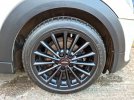Tyre rubber cracking is not a new phenomenon but something which many people are blissfully unaware of because it involves a wee bit of effort to notice. Super V8 has listed the main "culprits" above but the main thing to take on board is that rubber hardens and becomes less flexible as it ages and you can't really stop it from doing this. You can slow the process by trying to avoid direct sunshine falling on the tyres, especially if you're not going to be moving the car for a while - number of days - of course a cool dark garage would be even better, and either putting the car up on blocks or inflating the tyre to it's max permissible pressure if for some months. If you want to go more deeply into this subject there's loads to look at on line.
Surface cracking is of little consequence but you don't want to let it get deep enough to allow moisture to reach the steel belt bracing layer under the tread which is how most modern radials are constructed as it will rust which will weaken it but also destroy the bond between the rubber and the casing so may well throw a tread when you are going fast - we've all seen tread rubber at the side of the motorway from destroyed tyres, haven't we? Tyre rubber and the cords of the casing are made from incredibly tough materials. If they partially shred, apart from the lack of vehicle control if at high speed, they can do an enormous amount of damage to body and mechanical parts of the car. It's not something you want to experience.
However, a slightly more subtle warning is being imparted to you when your tyres start cracking, which few people ever consider. They are cracking because the rubber has aged and become less compliant (harder) a direct result of this lack of compliance is that the tyre will not grip the road anything like as well as when it was new. I was reminded of this when I recently decided to change the tyres on my
Ibiza. The original "big name" tyres had done well, although I always thought they were not as good in the wet as I would have liked, having done some 24,500 miles in six years of ownership and still with 3mm aprox on them. I don't like to go much below 2mm on tread, they were showing signs of light cracking and were prone to ploughing straight on (under steering) if pushed into a corner in the wet - very annoying on roundabouts. This was undoubtedly due to the tread rubber hardening. Here's a couple of pics of the cracking
If your tyres exhibit these cracks then they are not dangerous in terms of likelyhood to structural failure - unless other problems exist. However stuff like braking distance and cornering performance will most likely be nowhere near what the manufacturer promised.
This next tyre is on our Panda.
I bought it to replace this old Barum
which had reached the 2mm but also was worn on the outer shoulder due to a worn bottom suspension arm on that side. The disappointing bit is that the Barum - a brand I like a lot (now owned by Continental) was somewhere around 6 or 7 years old and showing no noticeable cracking whereas the new, "budget" tyre started to show these cracks after about 2 years. As you can see, it's not done many miles either. Ah well, you buy cheap and take your chances I suppose. I'm still not really very sure why I bought it because I usually buy "upper" mid range brands of tyres - like the Barums -This one was offered at a price I just couldn't refuse though and by a local small tyre supply outlet where I've bought bargains before. The name was unknown to me but it was one of those weird names you so often see on tyres from "dodgy" far eastern manufacturers. Oh well, you live and learn. I bought Falkens for the
Ibiza and I'm delighted with them. I've just driven Edinburgh to Salisbury then Devon and back to Edinburgh on them. The outward journey was nearly 3 weeks ago and in absolutely torrential rain for much of the journey. Driving quite quickly down the A702 in heavy rain was a delight with excellent grip both on corners and braking (it would have been clean underware needed to have tried it on the old tyres) and cruising on the M6 and M5 felt surefooted in a way that the old tyres never did even when new.
So, if you see appreciable cracking of the rubber on your tyres - and don't ignore the sidewalls too will you, especially around the "bead" - where the tyre seals to the rim. If it's on the sidewall you probably need to renew the tyre unless it's very obviously surface crazing only. If it's in the tread take a small screwdriver and try to open the crack to see how deep it goes - you are unlikely to do any further "damage" to the tread with a sensibly used screwdriver. It would have to be sharp and you'd need to be very rough with it to do that. If you recon the crack is getting anywhere near the casing cords (and I've seen them where you can see the steel cords if you do this) then it's time for a new tyre. Keep in mind too that a tyre displaying general surface (not deep) cracking is trying to tell you to take things easy because it's likely not to grip very well and especially in the wet.



